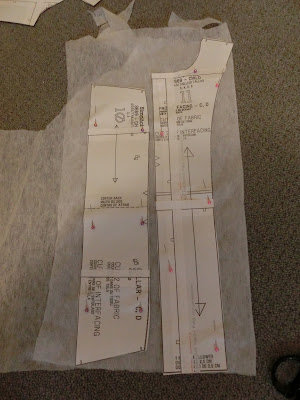Sewing the Shirt
I was all ready to fire up my overlocker - also known as a serger. I spent 10 minutes threading it up with some lovely pink thread and was eager to get going. Then I read the instructions:
"Stay-stitch around the neck." Wait a minute...that needs to be done on a regular sewing machine, not an overlocker - noooooo!
I have recently acquired an overlocker and love it - it's like driving a hot-rod after only having ever owned a practical-but-boring family sedan. It's quick, it's noisy and it
gets things done! It rocks. Maybe that's why they call them ロックミシン [rokku mishin] in Japan.
So the stay-stitching is done and I'm finally ready to fire up the mishin, erm, machine. I go back to the instructions: "Serge shoulder and side seams" *hooray!* "down to large dots." Oh man, now I have to get out my marker pen and pattern pieces.
Now, I would usually mark the dots during the cutting process but my marker pen is one of those disappearing ink ones. It's great but sometimes the markings only last a few days. This can be a little bit frustrating when I leave a project for a couple of days and come back to find that all of the dots and markings have disappeared.
Now it's finally time to use the overlocker! Woo hoo!
And because the thing is so efficient, it only took about 30 seconds to do the job. Oh well.
Now we have something that looks a little bit more shirt-like. Now it's time to fuse the interfacing to the top collar and button placket pieces.
So I get out my trusty iron (pronounced the Japanese way - iRon) and my miniature ironing board.
Fun fact: Most ironing boards in Japan are stupidly small - mine is the size and shape of a kick board. The size would make sense if the clothes and irons were also tiny but everything else is regular-sized! It's also only about 25 cms high so I have to kneel or sit on the floor while ironing. It can be particularly annoying when ironing men's shirts. Place garment on ironing board, iron, scootch garment over a bit, iron, scootch again and repeat.
So now on to the collar. We have to cut some notches and fold the middle bit up. The reason for this is a mystery but I'm sure it will become clear eventually.
Then we stitch around the collar, right sides together and trim off the seams and corners. Done!
Top stitch around the edge and we have a pretty nifty-looking collar!
Now the pattern instructions say to baste the underside of the collar to the neck edge. (I prefer the term 'tack' to 'baste' - baste seems like it should involve a turkey.) This instruction seemed a bit strange because the collar has been the last thing to sew on every other shirt I have ever made. But, whatever you say Simplicity-san...
So our shirt is finally coming together.








































